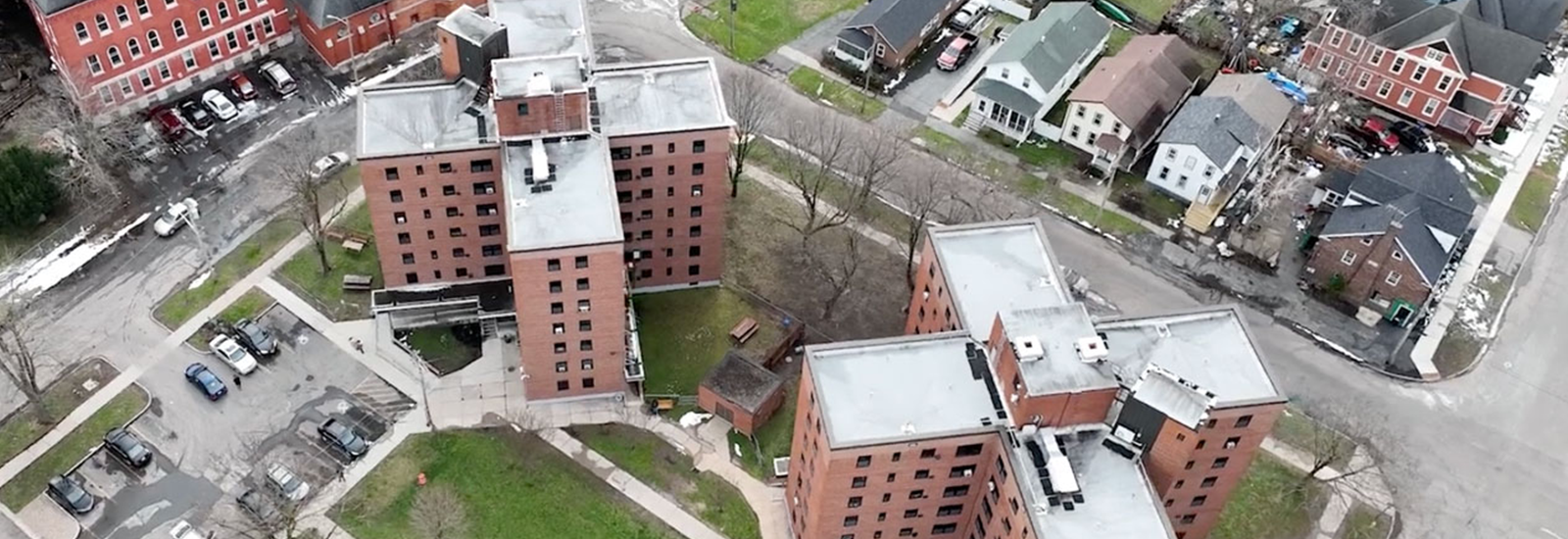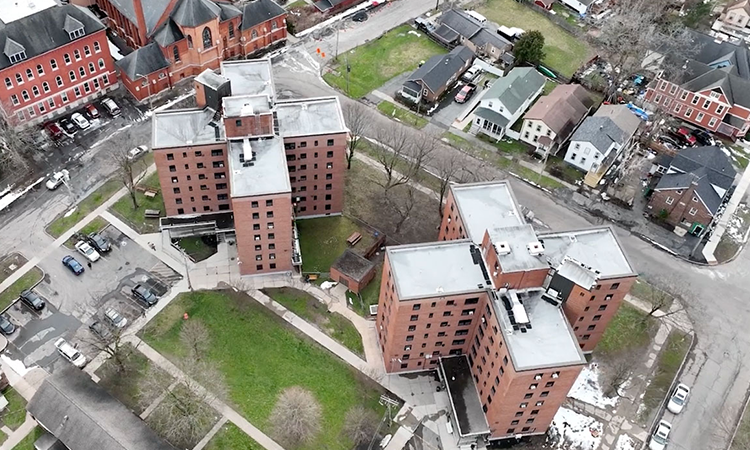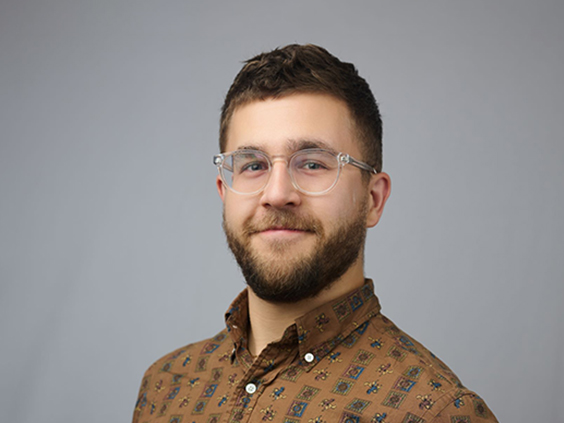Key takeaways
- Aging buildings in the U.S. could have heating, ventilation, and air conditioning (HVAC) systems that can be uncomfortable, inefficient, or even unhealthy for residents, according to engineer and inventor David Goldstein.
- A new modular panel from Goldstein’s Hydronic Shell Technologies, winner of the Housing Affordability Breakthrough Challenge, could effectively modernize these buildings’ HVAC systems without disruptive renovation projects that displace residents.
- If they’re found viable, these panels can make housing more livable, sustainable, and resilient, particularly as cities weather climate change.
[Video overview: David Goldstein, Founder & CEO of Hydronic Shell Technologies; Bill Simmons, Executive Director of Syracuse Housing Authority; Dom Lempereur, Chief of Engineering at BlocPower; Lisa Hart, Public Health Analyst & Grants Manager at Syracuse Housing Authority; and resident Dason Motayne talk about a new technology that could effectively modernize aging buildings’ HVAC systems without disruptive renovation projects that displace residents.]
[Music]
[David Goldstein, Founder & CEO, Hydronic Shell Technologies]
My name is David Goldstein. I’m the founder and CEO of Hydronic Shell Technologies. And our mission is to modernize and decarbonize the old, outdated buildings that we have in cities throughout this country.
[On-screen text]
Hydronic Shell Technologies was awarded $3 million from the Housing Affordability Breakthrough Challenge, an innovation competition from Wells Fargo and Enterprise Community Partners.
[Goldstein]
Water is really an optimal way to move heating and cooling throughout the building.
We developed a way to install that new infrastructure. So all the ducts, the pipes, the wiring is all integrated into a new facade or a new shell that’s wrapped around the building.
[Dom Lempereur, Chief of Engineering, BlocPower]
That’s one of the reasons why BlocPower has been very interested in a partnership with Hydronic Shell.
[On-screen text]
BlocPower participated in The Wells Fargo Innovation Incubator (IN2), a program with the National Renewable Energy Laboratory supporting cleantech startups.
[Goldstein]
We’re providing a technology that innovation partners can then take to actually implement in the field. And that’s exactly what BlocPower does.
[On-screen text]
Hydronic Shell and BlocPower are pilot testing this new technology in Syracuse, NY.
[Bill Simmons, Executive Director, Syracuse Housing Authority]
The Syracuse Housing Authority manages 2,700 units of affordable housing in Syracuse and Onondaga County.
[Lisa Hart, Public Health Analyst & Grants Manager, Syracuse Housing Authority]
The building that this project is in was built in 1953. They didn’t have anywhere near the code requirements that you have now.
[Dason Motayne, Resident]
This is a very old building, and it can get cold, it can get hot, it can retain heat, gets very dusty…
[Simmons]
We’re always looking to reduce the carbon footprint and reduce energy costs, and this new technology with Wells Fargo really helps us out tremendously.
[Hart]
Most of the times, you’d have to go inside the building to do all of that retrofitting. Where would residents go?
[Goldstein]
So what we’re looking at here is a prototype Hydronic Shell facade panel. And so this is all of the HVAC you need to provide full heating and cooling and ventilation to an apartment.
What they’re going to see is this window is gone. And in that space where we extend the windowsill, that’s where you’ll see the grill for the hydro box. The heating, the cooling, the fresh air is all going to come into the apartment through that grill. And so it’s not actually taking up any space within the apartment.
[Lempereur]
We see Hydronic Shell as a technology and an approach that can be replicated in any type of affordable housing.
[Goldstein]
When somebody sees that you got support from Wells Fargo, it brings a lot of validation that’s of huge value to the company. Our hope is that this project can really be a catalyst for a full community revitalization.
[On-screen text]
© 2024 Wells Fargo Bank, N.A. All rights reserved.
Watch the video: David Goldstein, founder of Hydronic Shell Technologies, will test his modular panels at a public housing community for seniors in Syracuse, New York. (2:54)
Credit: William Gallego
Upstate New York’s snowy winters don’t get to Dason Motayne, but the sweltering summers, which outcompete his mid-century apartment’s air conditioning, do.
“I think [my AC] is about to die,” he said. “It’s an old building, so it’s hard to regulate it in the summertime.”
That old building — the 418 Fabius senior public housing complex in Syracuse, New York — is far from unique. It was built in the 1950s, a time when the U.S. government authorized a huge influx of some 135,000 units of public housing per year. In 2018, inspectors found more than one in four public housing units were in a state of disrepair (PDF). Whether due to poor insulation or little to no air conditioning, these public housing buildings struggle with cooling, which means that the disproportionately older and chronically ill residents are more vulnerable to poor indoor air quality and worsening heat waves.
“Heating and cooling are major factors deciding quality of life around the world.”
Unfortunately, these types of public housing buildings have seen fewer investments or innovations that could make them more comfortable — and more environmentally sustainable, said Bill Simmons, executive director of Syracuse Housing Authority, which owns 418 Fabius.
“Who’s there to speak for the little guy to say, ‘Let’s try it here in public housing,’ where we could benefit and our resources are very, very scarce?” Simmons said.
Enter David Goldstein. Together with Lisa Hart, a public health analyst and grants manager at Syracuse Housing Authority, Goldstein is hoping to use public housing as a place to demonstrate a new innovation that could enhance aging buildings around the globe.
“Heating and cooling are major factors deciding quality of life around the world,” Hart said. “It’s the lowest income population who’d be able to benefit first from this project.”
How can occupied buildings be retrofitted for a net-zero future?
In Queens, 250 miles from Syracuse, Goldstein looks out the window of his home office and sees our heating-cooling problem — and a potential solution.
“I have a nice view of Manhattan, and even in just New York City, there are literally hundreds of thousands of buildings that need to be retrofitted if we want to be net-zero by 2050,” he said. “We’re just not going to do open-heart surgery on all these buildings.”
In 2020, Goldstein, an experienced mechanical engineer, was pondering this view when it dawned on him: “Why not wrap buildings in a heated blanket?”
Goldstein invented prefabricated, modular panels with heating, cooling, and ventilation that are installed onto a building’s façade. They can work with a variety of energy-efficient HVAC systems, including heat pumps. With these panels, a retrofit — rather than a costly rebuild — can bolster insulation, replace leaky windows, and filter indoor air of mold, smoke, and other pollutants.
These first-of-their-kind panels may work especially well for large-scale housing projects where people already live. By installing the panels from the exterior, residents may be minimally disrupted.
Goldstein founded Hydronic Shell Technologies to test his idea on real buildings. Its potential is huge. Modernizing older, inefficient buildings helps to improve unhealthy indoor air quality, reduce energy use, and save residents money. It could also help to save lives and improve residents’ quality of life.
“I couldn’t just turn my back on these people that need help,” he said. “I really think I can help them.”
Funding and partnerships can make scalable decarbonization a reality
Goldstein needed help to get his system out into the real world. He turned to the Housing Affordability Breakthrough Challenge, a $20 million competition from the Wells Fargo Foundation and Enterprise Community Partners to scale innovative housing solutions. One of six winners in 2023, the startup received a $3 million grant, paving a way for Goldstein to develop a prototype.
Once the prototype passes a series of tests, the technology will be installed for the first time on a wing of 418 Fabius in Syracuse. The project is expected to begin in late 2025.
Among the project partners is BlocPower, another startup that received support from Wells Fargo to help more communities access the benefits of clean energy technologies. The Brooklyn, New York-based company participated in the Wells Fargo Innovation Incubator (IN²) program and is now overseeing community engagement and construction management for Hydronic Shell’s efforts in Syracuse.
“I couldn’t just turn my back on these people that need help.”
“Support that’s coming from Wells Fargo is really helping to fund that [cleantech] ecosystem,” Goldstein said. “As an industry, we can develop those innovative, those outside the box, solutions that we need in order to solve these huge challenges.”
Dom Lempereur, chief engineer at BlocPower, says if the Syracuse project is successful, the company could plug Goldstein’s technology into affordable housing retrofits nationwide.
“From a construction perspective, it’s brilliant,” he said. “If we can demonstrate this [in Syracuse], we’ll be extremely interested to have this as part of our offering.”
What will success look like? Goldstein will be measuring energy use, indoor air quality, and heating and cooling after the retrofit. But one of the most important markers will be if residents love it.
“What I hope will happen is that people in other buildings start demanding it,” he said.
If they do, it could be the first step into making Syracuse, and then the country, more sustainable.
“This could be so much bigger than this one building,” Hart said. “This invention could really be a worldwide phenomenon. Everywhere in the world needs to decarbonize.”






